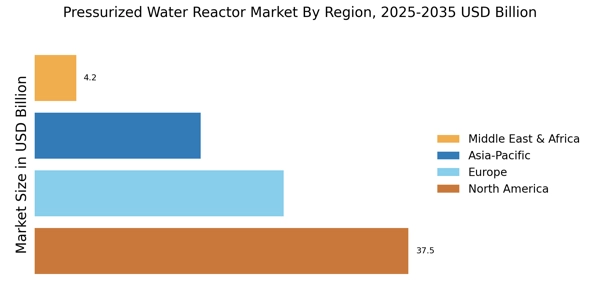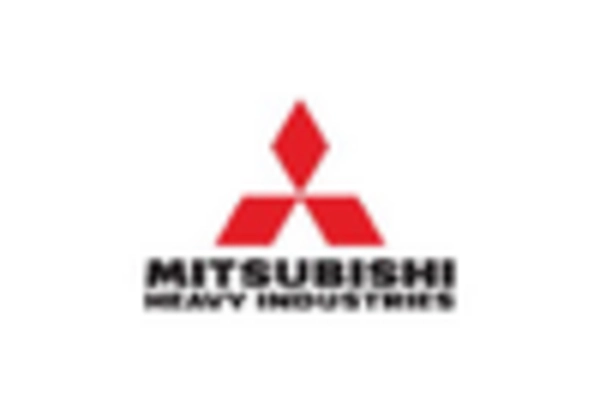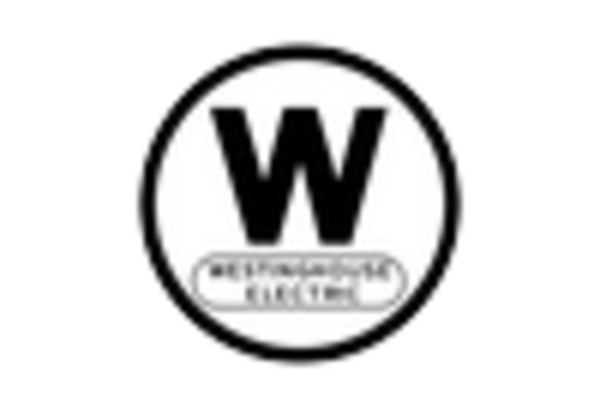Increasing Energy Demand
The Pressurized Water Reactor Market is experiencing a surge in demand for energy, driven by population growth and industrialization. As economies expand, the need for reliable and sustainable energy sources becomes paramount. Pressurized water reactors, known for their efficiency and safety, are increasingly viewed as viable solutions to meet this growing energy demand. According to recent estimates, energy consumption is projected to rise by approximately 30% by 2040, necessitating the expansion of nuclear power capabilities. This trend indicates a robust market potential for pressurized water reactors, as they can provide a stable and low-carbon energy source, aligning with global efforts to reduce greenhouse gas emissions. Consequently, the increasing energy demand is a significant driver for the Pressurized Water Reactor Market.
Growing Focus on Energy Security
The growing focus on energy security is a significant driver for the Pressurized Water Reactor Market. As nations grapple with fluctuating energy prices and geopolitical tensions, the need for stable and reliable energy sources has become increasingly apparent. Pressurized water reactors offer a solution by providing a consistent energy supply, less susceptible to external disruptions. Recent analyses indicate that countries investing in nuclear energy are better positioned to achieve energy independence and reduce reliance on fossil fuels. This strategic shift towards nuclear power is likely to gain momentum as governments prioritize energy security in their energy policies. Consequently, the emphasis on energy security is a vital factor influencing the growth and development of the Pressurized Water Reactor Market.
Investment in Nuclear Infrastructure
Investment in nuclear infrastructure is a critical driver for the Pressurized Water Reactor Market. Governments and private entities are recognizing the need to modernize and expand existing nuclear facilities to enhance energy security and sustainability. Recent data suggests that investments in nuclear infrastructure could exceed $100 billion over the next decade, focusing on the construction of new reactors and the refurbishment of aging plants. This influx of capital is likely to stimulate technological advancements and improve operational efficiencies within the industry. Furthermore, as countries strive to meet their climate goals, the role of pressurized water reactors becomes increasingly vital, positioning them as a cornerstone of future energy strategies. Thus, the commitment to nuclear infrastructure investment is a key factor propelling the growth of the Pressurized Water Reactor Market.
Regulatory Support for Nuclear Energy
Regulatory support for nuclear energy plays a pivotal role in shaping the Pressurized Water Reactor Market. Governments are increasingly implementing favorable policies and streamlined approval processes to facilitate the development of nuclear projects. This regulatory environment is essential for attracting investment and ensuring the timely deployment of new reactors. Recent trends indicate that several countries are revising their nuclear regulations to enhance safety while promoting innovation. For instance, the introduction of risk-informed regulatory frameworks is expected to expedite the licensing of new pressurized water reactors. Such supportive measures not only bolster investor confidence but also contribute to the overall growth of the nuclear sector. Consequently, the regulatory landscape is a significant driver influencing the trajectory of the Pressurized Water Reactor Market.
Technological Innovations in Reactor Design
Technological innovations in reactor design are transforming the Pressurized Water Reactor Market. Advances in materials science, safety systems, and operational efficiency are leading to the development of next-generation reactors that promise enhanced performance and reduced environmental impact. For example, the integration of digital technologies and automation in reactor operations is expected to improve safety and reduce operational costs. Furthermore, innovations such as small modular reactors (SMRs) are gaining traction, offering flexible deployment options and the potential for lower capital costs. These advancements not only address the challenges of aging infrastructure but also align with the increasing demand for clean energy solutions. As a result, technological innovations are a crucial driver propelling the evolution of the Pressurized Water Reactor Market.


















Leave a Comment